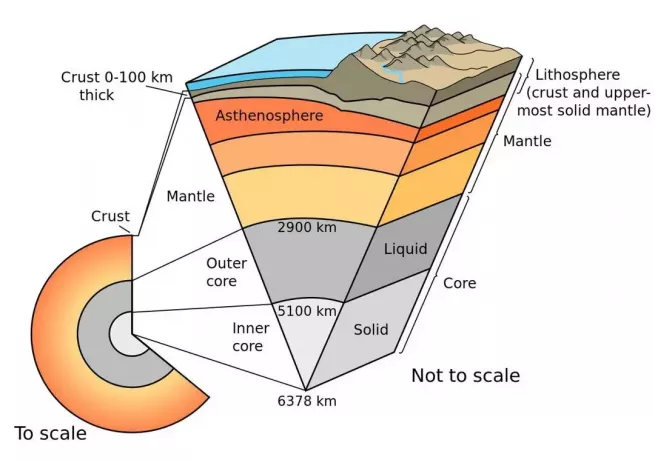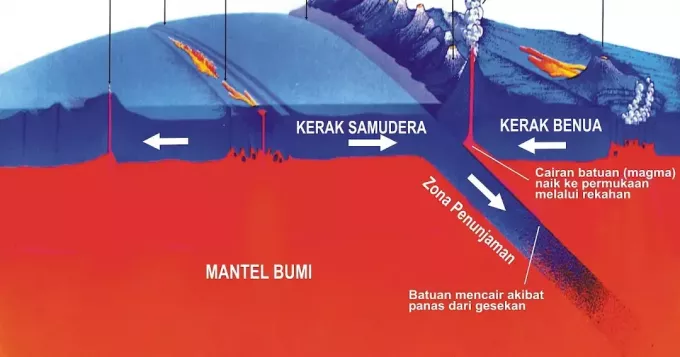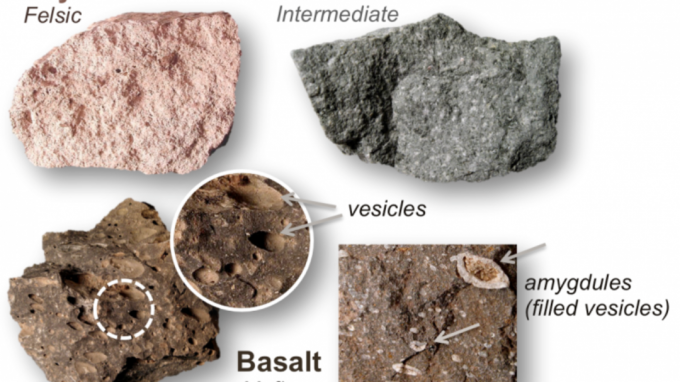Lithosphere Matter: Structure, Function, Composing Rocks
Loading...
Lithosphere is a term derived from the Greek words 'lithos' which means rock and 'sphere' which means sphere. The lithosphere can also be defined as the layer of rock that forms the earth's crust.
The thickness of the earth's crust on the outside or the very top is about 100 km. This layer consists of rocks. However, it does not consist of only hard rock elements. There is also clay, volcanic ash, sand, gravel, rocks and other types in this layer.
List of contents
Definition of Lithosphere

This layer is the outermost layer of the earth's crust and is composed of rocks and minerals. The rocks that make up this layer are igneous rocks, sedimentary rocks, and metamorphic rocks. The mother of all these types of rock is magma.
The earth's crust is generally divided into two types, namely the siamese layer at the top and the sima layer at the bottom. The sial layer is the upper crust which consists of two kinds of crust including oceanic crust and continental crust.
Usually, this layer of the earth's crust will be arranged according to the shape of the earth's surface and can consist of rocks as well as minerals. In general terms, this layer is often referred to as the earth's surface.
There are two main parts of this layer, namely the upper lithosphere or also often referred to as the land surface (composing 1/3 or approx 35% of this layer) and the lower lithosphere or more commonly called the ocean floor (composing 2/3 or about 65% of the seafloor). this).
Rocks are the main constituents of this layer. The main parent of a rock is magma or molten rock that has a high temperature found in the earth's crust. This magma will go through several stages so that it can turn into rock that is no longer hot anymore or is called igneous rock.
Read: Definition of Geography
Functions of the Lithosphere

This layer has a function large enough for life on earth. Which at the top is a residence for humans, animals, and plants.
Humans can carry out activities above this layer. Then, the bottom layer usually contains mineral ingredients that provide many benefits for humans.
Mineral or mining materials produced by the lower layers include oil and gas, gold, coal, iron, nickel, and also tin.
This layer also provides some of the materials needed by humans to meet their daily needs. In this layer, humans can also build space for shelter, cultivate crops, create agricultural land, plantations and many other places.
This layer does play an important role in plant life. Soil will be formed if the rocks on the surface of this layer undergo degradation, erosion or other physical processes into small rocks to become sand.
Then in this section it is mixed with the input of organic components of living things which will later form soil that can be used as a place to live for these living things. Soil is also a source of various types of minerals for various organisms.
In their natural form, these minerals can be in the form of rocks that lie layered on the earth's surface. Through the process of erosion, various minerals that are a source of food for these living creatures are often carried along with rivers to the sea and are also deposited on the ocean floor.
The Structure of the Earth's Skin Layer (Lithosphere)

1. Damn Layer (Si Al)
This layer is the earth's crust which is composed of silicon and aluminum, these compounds are SiO2 and AL2O3. This layer is usually found on land and continents. This layer is also called the crust, which is dense and rigid with an average thickness of 35 km.
This crust is also divided into two parts including:
- Continental crust, which is solid and consists of igneous granite at the top and basalt igneous rock below, also occupies part of the continent.
- Oceanic crust which is a solid object and consists of deposits in the ocean at the top, which is the bottom usually composed of gabbro and peridotite rocks and occupy part of the ocean then at the bottom of the rock volcanic.
2. Sima Layer (Si Mg)
This layer is a layer of the earth's crust which is composed of several metals silicon and magnesium which are available in the form of compounds of SiO2 and MgO.
This type of layer has a higher density than the sialic layer because of the iron and magnesium, including basalt and ferromagnetic minerals. This sima layer is an elastic material and has an average thickness of 65 km.
This layer is usually the outermost layer of the earth's crust and is granite, so it can also be called granites. This is because the dominant constituent material is granite. This layer of granites is 10 km thick, but granites are not found everywhere.
After this granitic layer there is a layer that is basalt, so it can be called a basaltic layer. This is because the material that makes up the layer is quite dominant in the form of basic basalt material. This basalt layer can be up to 50 km thick.
Read: Geography Research
Lithosphere Composing Rocks
Rocks can be called a collection of minerals that have frozen. Rocks or can also be called elements of the earth's crust that provide various inorganic minerals through the weathering process and produce soil.
Rocks have different mineral compositions, physical properties and ages. This layer is able to form because of 3 main rock types which have the basic material in the form of frozen lava after going through several processes over a long period of time. Here are the types of rocks:
1. Igneous Rock

Igneous rock is a type of rock formed from cold and hard magma through or without a crystallization process. It can also be said that igneous rock is also a rock formed from the freezing of magma.
The main property of this igneous rock is crystalline. Either from the crystal itself or from the crystallized glass. Based on genetics, igneous rocks can be divided into 2 types, namely:
Intrusive Igneous Rock
Intrusive igneous rock is igneous rock that is cold and hard beneath the surface or in the earth's crust surrounded by the original rock. This magma cools slowly and will make this rock has a coarse grain.
The structure of intrusive igneous rocks is usually typical and consists of batholiths, stocks, lacoliths, sills, and dikes. Intrusive rock or intrusive igneous rock also has a rough texture such as granite, gabbro, and diorite.
Extrusion Igneous Rock
Extrusive igneous rocks are cold and hard igneous rocks that exist on land or below sea level. These rocks can also be referred to as volcanic rocks.
Advertisement
In addition, based on where the frozen magma is formed, igneous rocks are also divided into three types, including:
Deep Igneous Rocks (Abiscus/Plutonic)
Igneous rocks generally occur from the freezing of magma that can take place slowly while still deep in the earth's crust. For example, deep igneous rocks such as granite, diotite, and gabbro.
Gang/Korok Igneous Rock
Igneous rocks occur through frozen magma in the passageway between the magma chamber and the earth's surface. Magma that seeps between these layers also undergoes a freezing process that will take place more quickly,
Therefore, the mineral crystals that are formed are not all large. The mixture of mineral crystals of different sizes is a characteristic of korok igneous rocks.
Outer Igneous Rock
Outer igneous rocks usually occur from magma that comes out of the magma chamber and freezes on the earth's surface, such as magma resulting from volcanic eruptions. Such as external igneous rocks such as: andesite, obsidian, basalt, diorite, scoria, pumice / pumice.
2. Sedimentary Rock (Sedimentary Rock)

This type of sedimentary rock belongs to the type of relief which is formed as a result of solidified deposits such as loose material.
Sedimentary rocks can also be referred to as deposits, these are rocks that are generally formed through the deposition of several materials carried by water or wind.
There is also a theory about sedimentary rocks, namely rock types formed through the process of sedimentation petrification is also lithification from weathering and erosion of deposited and previously deposited soil drifting.
Experts also state that these sedimentary rocks are included in rocks that are formed through sediment consolidation. Such as loose material in the depositional location which is transported through water, wind, ice and landslides due to gravity and also landslides.
Besides being formed from this, sedimentary rocks can also be formed by evaporation of a solution of calcium carbonate, silica, salt, and various other materials. Thus it can also be called a sedimentary rock. The following are types of sedimentary rock:
Clastic Sedimentary Rock
These rocks are also called detritus sedimentary rocks, mechanical, exogenous can also be called sedimentary rocks which there are some clastics or crushed rock that can naturally settle or by gravity separately.
These rocks can be formed from existing rocks and reworked from before. The process that occurs as rock formation includes weathering, erosion, transportation, and redeposition or re-deposition.
In order for the process to occur properly, several media such as water, wind, ice, and gravity are needed. It could also be through this gravitational medium as a result of rock slides.
There are several examples of this type of sedimentary rock, including breccia, conglomerate, sandstone, or slab rock. Breccia rocks are also called gravel deposits which have sharp angles that are still close to the place of origin.
Conglomerate stones are also gravel deposits that have rounded corners or corners that are far removed from the river flow. Meanwhile, sandstone is a sedimentary rock originating from rock fragments with a size of 1/16 to 2 millimeters.
Non-clastic Sedimentary Rock
Non-clastic rocks are rocks that are formed through the evaporation of a solution or also material that settles and also comes from the same place.
The process of rock formation can also occur by chemical, biological or organic processes. In addition, the combination of the two is like a combination of chemistry and also organic and biological.
The process which is a combination of the two is biochemistry. The process of rock formation usually occurs organically and is a process of formation through natural activities such as by animals and plants.
For example, the process of organic rock formation is the formation of marine animal homes or corals. The existence of animal shells (fossils) and the burial of various woods as a result of the land descending into the ocean.
3. Organic Sedimentary Rock

Organic sedimentary rock, as the name implies (organic) is formed as a result of the activity of organisms or living things. Thus, the remains of these living creatures become the most dominant substance in the rock structure.
Various types of living things that are commonly found as constituents of organic sedimentary rocks include corals, molluscs, diatoms, radiolaria, foraminifera, and also several types of plants.
Based on the dominant minerals that are usually produced, there are also two types of organic sedimentary rocks, namely silica sedimentary rocks and carbonate sedimentary rocks:
Carbonate Organic Sedimentary Rock
Carbonate organic sedimentary rock is an organic rock that is quite dominant. Organisms that produce these rocks such as corals, molluscs and foraminifera. The minerals that make up include carbonate compounds in the form of calcite such as limestone.
Silica Organic Sedimentary Rock
The living things that make up silica organic rock are diatoms and radiolarians. Diatoms usually produce diatomite silica rock types, while radiolaria will later form radiolaritic silica rocks.
4. Malihan Rock (Metamorphic)

Metamorphic rock is a rock formed due to high pressure and temperature. In contrast to igneous rocks that are only formed at high temperatures, but not under high pressure.
Metamorphic rock can be referred to as metamorphic rock or metamorphic rock in English. As the name implies, this type of rock undergoes a metamorphosis process until it finally changes the mineral structure in the original rock into a new rock.
Minerals are rock-forming elements. Every mineral in metamorphic rock will experience changes. In the classification of metamorphic rocks, known as index minerals as constituents.
The index minerals in metamorphic rocks include silimanite, kyanite, olivine, pyroxene, amphibole, staurolite, andalusite, mica, feldspar, and quartz. Minerals of this type usually react to the metamorphosis of rocks.
In addition, metamorphic rocks are also formed due to the crystallization process of igneous rocks. Each metamorphic rock will be unique due to the different ways or processes of formation.
There are 6 forms of metamorphic rock including contact metamorphic rock, regional metamorphic rock, superimposed metamorphic rock, catalytic metamorphic rock, hydrothermal metamorphic rock, and metamorphic rock impact.
Read: Mainland Relief
Example of lithosphere
The shape of the earth's surface that is not similar will have an impact on human life. Various examples of this layer are the shape of the earth's surface including lowlands, hills, and mountains.
1. Lowland

According to experts, low-lying areas are usually located between 0-700m above sea level. This area is usually the center of various activities such as transportation, trade, companies, and industry.
2. Hill

The plateau or hill area is located at an altitude of about 700m. This area is suitable for coffee and rubber plantations. The agricultural system used is a dry land farming system (horticulture) including vegetables, fruits and ornamental plants.
3. Mountain Area

In underdeveloped areas, mountains can make transportation and communication very difficult. Usually the settlements in this area are centered in valleys that are close to water sources.
Well, above was an explanation of the lithosphere. As living beings, of course, we must know and take care of this part of the earth well.
X CLOSE
Advertisements
ADVERTISEMENT
X CLOSE
